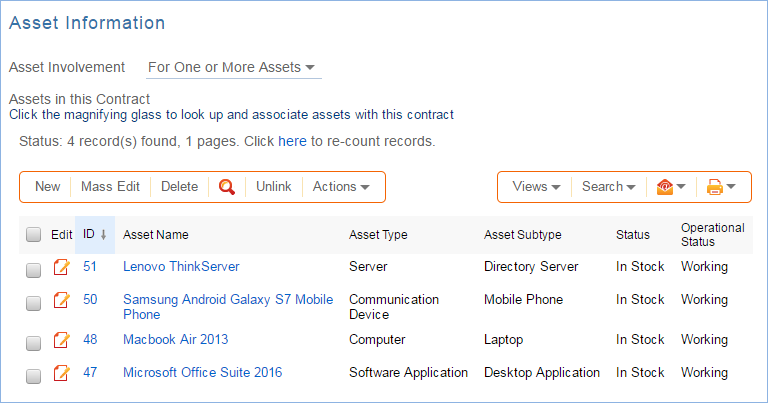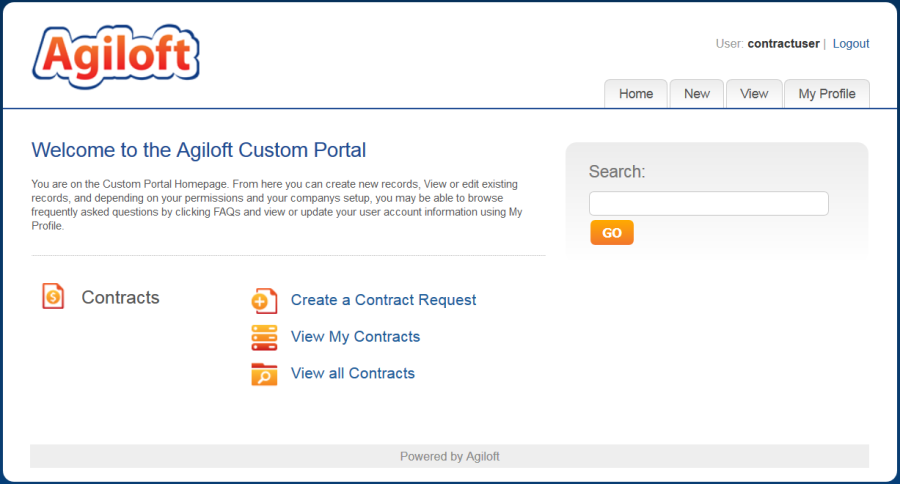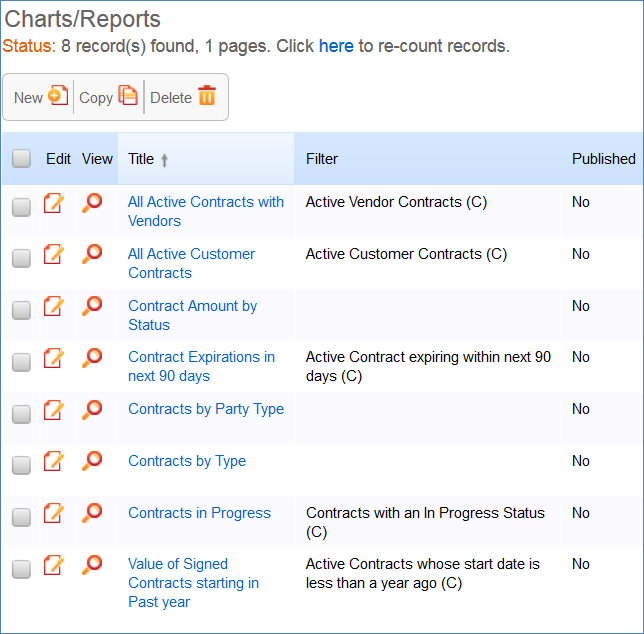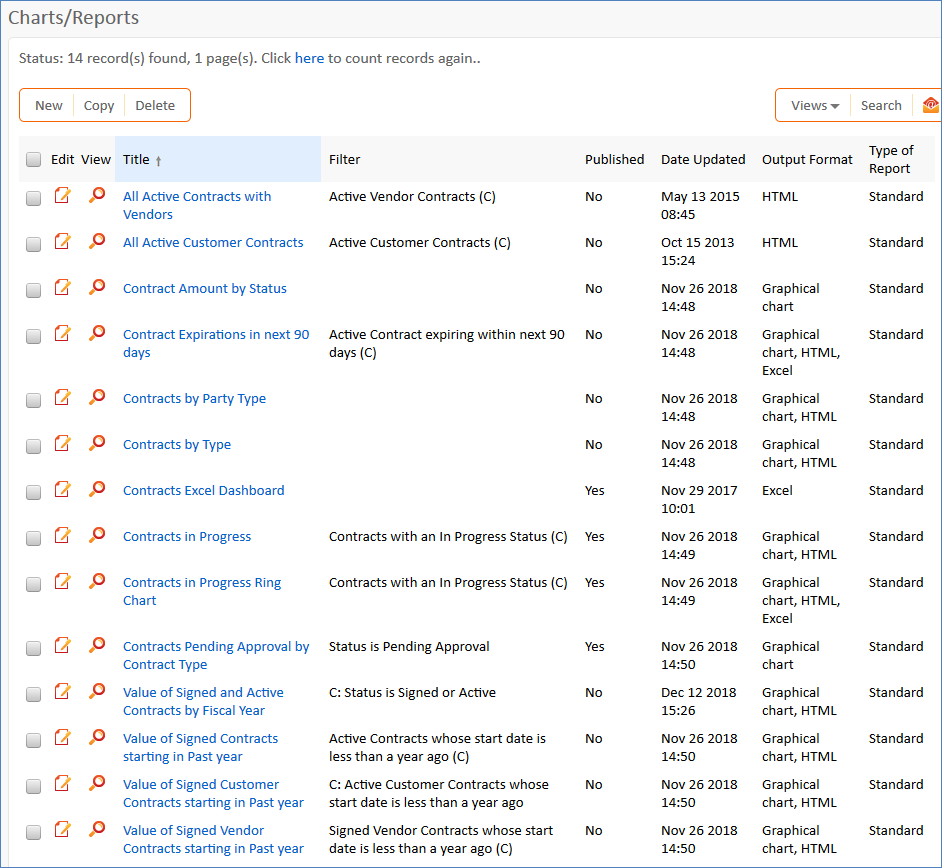The Contracts table holds all contract records. It also controls the associated automation and notifications related to contracts. Part of a representative record is shown below.
Required fields, marked with a red asterisk, include: Record Type, Internal Contract Owner, Contract Type, Days in Advance to Notify for Renewal, Contract Title, Contract Description, Contract Start Date, and Contract End Date.
...
The Record Type field in the common area indicates the contract's category. "Contract" is the default Record Type for newly created contracts. It can be used to indicate either a stand-alone contract or a contract that exists under a master agreement. In the latter case, the Parent Contract ID can be filled in upon creation of the contract. Subcontracts and Amendments will be linked to a parent contract automatically, if they are created by clicking the Create Related Contract button in the parent contract record.
Below the Record Type are fields storing the Assigned Team and the Internal Contract Owner. The default Assigned Team is the Contract Manager Team. The Internal Contract Owner is the person responsible for overseeing the contract and ensuring timely renewals and approvals. The list of available owners is filtered to users who are in the Contract Owner Team or the Contract Manager Team. The default Internal Contract Owner is the user who creates the contract record, provided that user is in the Contract Manager or Contract Owner Team. Users in the Contract Manager or Admin group can manually change the Assigned Team and Internal Contract Owner if needed.
...
Attachments can be automatically generated from inbound emails containing attached files. Files from inbound emails are mapped to the Transitional Contract Files field in the contract, assigned a predetermined Attachment Title and Attachment Type value of Document Provided by Outside Party, and then converted into a new attachment record. The file is mapped into the Attached File field in the attachment record. If multiple files are attached to an inbound email, each one is converted into a separate attachment record for that contract.
Working with Attachments
The All Contract Attachments related table is also used to manually create and attach files to the contract, such as supporting documents, signed agreements, or other documents from the contract parties. Create attachments from within the contract record by clicking New on the related table's action bar.
The Select Files drop-down on the action bar is used to operate on multiple selected attachments to update the fields to the far right in the table view. Add or Remove for the Approval Packet sets the Include in Approval Packet field to Yes or No. Add or Remove for the E-sign Packet changes the To Be eSigned field to yes or no. And Set Status to Superseded sets the status for the selected attachment(s) to Superseded.
Tracking company documents and insurance certificates
The Attachments tab also holds a related table that can be used to track insurance certificates separately from other types of attachments. Certificates can be found directly in the Insurance Certificates table, and in related tables in both the Company and Contracts tables.related tables of company documents and insurance certificates. The Create New Company Document button opens a new company document record linked to this contract.
For more information on company documents, see the Company Documents Table section.
Insurance certificates can be found directly in the Insurance Certificates table, and in related tables in the Company, Contracts, and Company Documents tables.
When you add an insurance certificate to a company record, it can be automatically linked to all pending or active contracts with that vendor by a daily time-based rule (disabled by default).
To create a certificate from a contract record, click New on the related table action bar; the certificate will be automatically linked to the contract. You will need to look up the company vendor in the For Company Name field when creating certificates from a contract.
based rule (disabled by default).
The Insurance Certificate Owner (defined in the company record) is notified fourteen days before an insurance certificate's Expiration Date. When a certificate expires without being renewed, the Contract Managers of any related active contracts are notified on the date of the expiration.
For more information about insurance certificates and related automation, see the Insurance Certificates Table section.
Another method for managing insurance certificates
...
If this method makes the most sense for your particular business, you can remove the default Insurance Certificates field from the contract layout. Then , go to the Attachment Type table and edit the record called Insurance Certificate. By default, this record's Status is Inactive; change the Status to Active to make it visible in the Attachments table.
...
The system automatically notifies the first approver in the sequence. A progress bar also appears in the common area to provide a quick visual reference of the approval process.
To advance the contract workflow, an approver will use one of three action buttons to change the Status of the approval record:
- Approve to send the contract to the next approver in the sequence.
- Require Changes to send the contract back to the contract manager to make changes.
- Permanently Reject if the contract requires significant changes.
Both Require Changes and Permanently Reject require the user to enter notes in the Approval Notes field. These notes are appended to the Approval Notes field in the contract record and are also viewable from any other approval record linked to that contract.
...
Notes relevant to the general contract process are entered into the General Notes field on the Details tab, and notes pertaining to the approval process are entered into the Approval Notes field on the Approvals tab.
Emails can be sent to Internal Contacts and External Party Contacts from the Emails tab. First choose the type of Recipient(s) (Internal Contacts, External Party Contacts, or External Party and Internal Contacts), then click the lookup icon to select the contacts to email. Fill out the Email Subject and Email Text fields as needed, select any files to send with the email, then click Send Email. The emails sent from the contract will be shown below in the Email Communication History.
Related Contracts and Renewals
...
If applicable, the system automatically links renewal contracts to any preceding contracts, creating a chain for auditability. Any assets linked to the preceding contract will be linked to the renewal contract as wella chain for auditability. Users typically do not enter information into the Renewal Contract and Previous Contract Information fields manually.
...
Any direct children of the current contract are shown in the table in the Related Contracts and Amendments section.
Related assets
Assets can be linked to individual contracts from the Assets tab. Assets must be added separately to the Assets table before they are available to attach to contracts. If you are not relating assets to contracts, you can simply remove this tab and its fields from the layout.
the table in the Related Contracts and Amendments section.
Signing contracts with DocuSign or Adobe Sign
A Signature tab appears to the right of the Assets Renewal / Related Contracts tab. This tab contains fields for contract document signers, and contains all fields related to DocuSign and Adobe Sign. If you are not using either system, these fields can simply be removed from the layout. The Files to Sign field holds attached files from the Attachments table that have a To Be eSigned value of Yes. The Refresh Files action button refreshes this field in case changes to the attachments were made in the same session under the contract's Attachments tab.
...
Once the contract is ready to sign, use the Create DocuSign Envelope action button to create a DocuSign Envelope record and attach the files held in the Files to Sign field.
This will also create a DocuSign Recipient record for each signer. These records are then shown in the related tables for DocuSign Envelopes and DocuSign Recipients on the Signature tab. Only users in the Admin and DocuSign Users groups can access the DocuSign fields on the Signature tab. For more information on DocuSign, refer to the detailed DocuSign User Manual at http://www.agiloft.com/documentation/docusign-users-manual.pdf.
...
Once ready to send for signature, click the Create Adobe Sign Envelope button.
This will create an Adobe Sign Envelope and convert the signers into recipients.
...
Similarly, the Status is changed when the Contract End Date occursarrives. If the contract does not have an associated renewal contract, the Status is automatically set to Expired; if the contract does have a renewal, the Status is set to Renewed. If the contract is auto-renewing, the Contract End Date is increased by the Renewal Term in Months and the contract remains Active.
To cancel a contract, click the Cancel Contract button in the common area. Additionally, users Users of the Admin group can also manually change the contract status Status to Canceled.
If the contract has a Status of Approved, the Mark as Signed Pending Signature button is visible in the common area. This button updates sets the contract Status to Signed. The Pending Signature.
The Pending Signature.
Once the Status of the contract is Pending Signature, a Mark as Signed button is a quick way to change the status to Signed.appears.
Turning Off Approvals
...
- Edit field permissions to allow the Contract Manager Group to edit the Contract contract Status field in their own contracts and in others' contracts.
- Remove status-changing buttons from the layout: Submit for Approval and Mark as Signed.
- Remove the Approval tab and related fields from the layout.
...
Members of the Contract Creator group are internal employees accessing the system via the end user interface. Contract creators, also called contract requesters, are users who submit requests for contracts but do not work on or manage the contract , once it is requested and submitted. Below is a representative home page for an end user in the Contract Creator group.
Creating Contracts
Users in the Contract Creator group may create contracts by clicking the Create a Contract Request link on the home page or by selecting New > Contract from the menu. A simplified contract form is presented to the end user. Many of the fields are hidden from the layout or restricted by field-level permissions.
In the Contract Party Information section, users can find and link to an existing company and contact, or create new ones as needed. Select New Company and then enter the name and address information. After the contract is submitted for review, Contract Managers can confirm the new company to finish adding a record. Similarly, end users can suggest a new company contact by filling out the fields in the Party Main Contact section of the form.
Once the required information is filled in, the contract can be saved for later revisions. The contract requester can also press the Submit for Review button to request approval from a Contract Manager. Contract requesters can be contacted to update the submitted contract, but they are typically no longer involved in the approval process from this point forward. After the contract requester submits the contract for review, a contract manager decides whether to continue with the approval process or reject the contract request.
...
At any time, the contract requester can view contracts they previously submitted by choosing View > My Contracts from the menu or by clicking on the View My Contracts link. Contract Creator group members can edit select fields in contracts they own. Certain fields such as Contract Amount, Contract Start Date, and Contract End Date (among others) are not editable by the contract requester if the contract's Status is Pending Approval, Approved, Signed, Active, Renewed, or Expired. This is to prevent changes to currently active or in process contracts.
...
Records in this table are owned by the Contract contract Requester. Specifically, a record is owned by the user whose ID matches the number in the Requester ID field. By default, the Contract Requester is the user who created the contract record.
...
The Contracts table contains the following default Charts/Reports:































